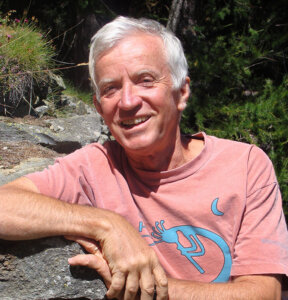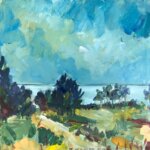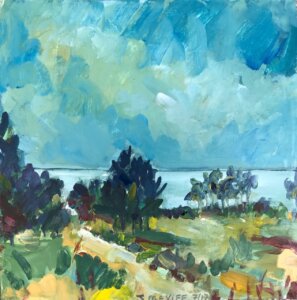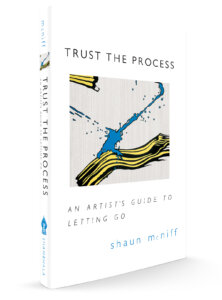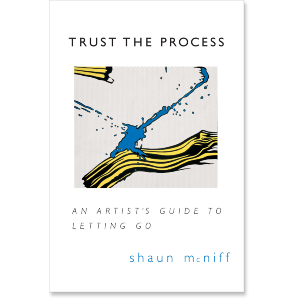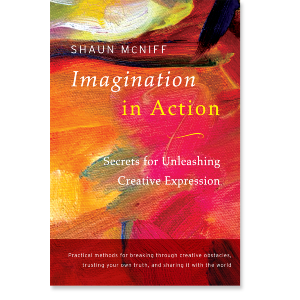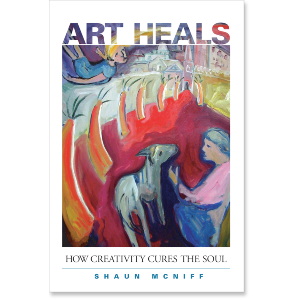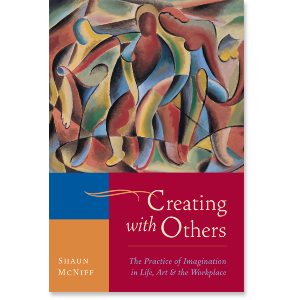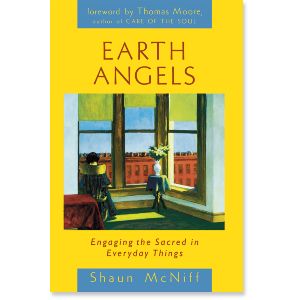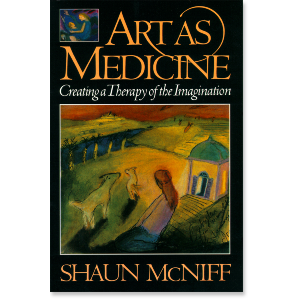My belief in the intelligence of the creative process has been affirmed by people who struggle in workshop groups where they are given opportunities to express themselves in the arts. Sometimes, people who are invited to express themselves freely will react with feelings of paralysis, fear, and intimidation. Memories of embarrassment and failure wrap them in what one woman described as a ‘‘cocoon.’’ The past traumas are often self-inflicted and not the fault of parents, teachers, or institutions. Even the best teachers of creativity encounter a common resistance to self-expression in their classes. The cocoon is spun partly from fears of self-disclosure. We all know intuitively that our spontaneous creative expressions elude the habitual monitoring of our inner censors, revealing things to others that are outside our conscious control. If we allowed our simple essence or our ungroomed emotions to show, we might look foolish, vulnerable, or unattractive. There is also the assumption that creative expression is only for the talented few and that our creation is a waste of time since it will never compare to what the ‘‘masters’’ do.
The typical person says, ‘‘I can’t do that.’’
Or, ‘‘This is ridiculous, a waste of time. I have more important things that I could be doing today.’’
It is intriguing how schoolteachers participating together in my creative arts workshops are often the most resistant to free and imaginative expression. Teachers are known for demanding clear directions and immediate applications because school is almost totally focused on training the literal mind.
There are many things that we teach in school that involve the mastery of sequential skills that build upon one another. Most of the educational system is established on the assumption that learning follows a logical and predictable pattern of acquiring knowledge. Educators are actually required to produce lesson plans and structure their classes around measurable outcomes. We then test the student at various intervals to determine whether or not they are performing within acceptable standards. Many people teach art in this way. They show the student how to draw a head by starting with an oval and then mathematically locate the placements of eyes, nose, ears, and mouth. This approach to teaching is technical and it has its place within the training of artists. Structure and openness are partners in every creation.
But there is very little emphasis within our educational systems on the education of the imagination, which requires sustained encounters with uncertainty. My experiences in working with teachers illustrate the benefits of acquiring the aptitude to embrace the unknown—what John Keats called ‘‘negative capability.’’
In my training groups with teachers I repeatedly observe that their initial resistance ultimately leads to rewarding experiences with creative unfolding. There are typically a series of difficult phases that the groups of teachers must pass through in understanding that the creative process is not something to be contained in lesson plans.
When I work with teachers in an extended creative arts workshop, there is a classic resistance that appears at the beginning. The doubt can be heard in their silence: ‘‘What’s the purpose of this? What’s it got to do with my classroom? What am I doing here?’’
Someone inevitably protests and questions the validity of what is happening. I experience fear and sense how easily everything can fall apart. Others join the protest, and the community divides. The group flounders.
I have learned that I must let ‘‘the process’’ follow its course. As frustration builds, someone as a rule challenges my ability and people in the group begin to confront one another. Others withdraw into themselves. It is always hard to see that doubt, fear, and indirectness are eternal aspects of the creative path.
When everything seems hopeless and going nowhere, I observe that the group as a whole is enacting how the process of creation works its way through an individual person. Strong feelings start to focus energy. People become keenly involved in spite of themselves. The process arouses emotion and draws everything into itself.
A new direction flows from the dissolution. There is a feeling of hope and transformation.
If we are able to stay with a situation, it will carry us to a new place. The ‘‘process’’ knows where it needs to go and if it is exclusively directed or controlled by any one person, we miss the opportunity to learn this lesson. There is a group mind or collective intelligence working in every situation and if we can trust it, and sincerely support its natural movement, it will astound us with its ability to use whatever we give it.
The psychologist Carl Rogers used to say that given the proper support and safety, every group will progress through conflict to a state of change and resolution. But in order for the process to become transformative, there must be a prevailing atmosphere of respect and empathy for the participants. These attitudes provide the essential environment that people need in order to risk new expressions, whether in the art studio, the classroom, the office, or the family.
Trust in the process assumes that there is a force that moves within a group, an individual, or a situation that is distinctly ‘‘other’’ and not subject to control. ‘‘It’’ finds the way through problems and complex interactions among people and as well as through conflicting forces within ourselves. Although outside the reach of explanatory definition, this force is well known to any person familiar with the situations I am describing. It is the primary carrier of creation.
Training people to work with the creative process begins with their personal immersion in it. How can we guide others in a territory we do not know ourselves?
In training graduate students to work with the arts in therapy and education, I encourage an ongoing personal engagement with creative expression. The graduate students experiment with creative expression and personally experience the processes that they encourage in others. Repeatedly I observe how the most pervasive outcome of these extended involvements with the depths of creative expression is a faith in the process. The more intensely the students struggle, the more deeply they discover how the process will ultimately carry them to a new place. As D. H. Lawrence suggested, the soul is perfect in its movement and its ability to minister to itself. We are needed as active participants, but we have to learn how to act forcefully while simultaneously stepping aside so that the process has the freedom to do its work.
What Carl Rogers said about groups also applies to an individual person’s experimentation with the arts. If we work in a safe and supportive environment with what Rogers described as ‘‘unconditional positive regard’’ for our expression, the process of creation will ultimately proceed to a stable and meaningful outcome. The most threatening element is the lack of confidence that people have when the process becomes difficult and tense. They don’t realize that the conflict and uneasiness that they are experiencing are necessary and ‘‘part of the process.’’ Transformation occurs when we lose our way and find a new way to return.
In my personal experience as a teacher, it was the student who fought and struggled the most in her research into the workings of the creative process who produced the most memorable and convincing study of how the creative spirit moves through our lives. The depth and wisdom of her findings were shaped through the authority of her experience. The student taught also me to trust the process, because I was the constant target of her frustration. When things were going badly, I was the object of her fury. It was very difficult, and I privately wondered whether I was doing the right thing. She needed someone to fight against, someone who would hold firm amid all the turmoil. What distinguished this student’s work from the more conventional nay-sayers and complainers was the way she stayed with the process. She gave it the opportunity to transform itself.
In the education of imagination we invariably confront the way in which people have been conditioned to expect certainties in learning situations. There is an expectation that something concrete will be delivered by the teacher to the learner.
In training teachers from every conceivable discipline to engage all of the arts and integrate them into their different work situations, I have observed that they generally come with the following assumptions: ‘‘Tell me exactly how to do it and how I can use this in my classroom.’’ They are oriented toward the individual technique, not the process that runs through every method and continuously generates imaginative ways of doing things. Within the creative process, variations and unusual perspectives are encouraged. A group of us might work for a period of time in the same room and with the same materials and end up in vastly different places. There is no one ‘‘correct’’ way of proceeding, and this aspect of creativity goes contrary to many ingrained ideas about instruction.
Personal immersion in the creative process helps teachers establish empathy with what their students are experiencing. In my work I am constantly involving experienced teachers in art experiences for the first time, and they repeatedly say, ‘‘Now I understand what the children are feeling.’’
The teachers describe how there is a pattern to the way they face every new art experience with resistance and fear. They feel an equally consistent thrill and satisfaction after completing each new phase of the work. Whether it is dance, storytelling, musical improvisation, painting, mime, or poetry, the same forces of creation move through the experience, affirming that there is something essential that cannot be taught when we focus only on specialized technical instruction.
Trusting the process is based on a belief that something valuable will emerge when we step into the unknown. There are elements of surrender and letting go which have more to do with flexibility and the ability to change direction, than with defeat and annihilation. The ego is willing to relinquish its plans and expectations in order to receive an unanticipated result. Experienced creators are able to step aside and relax in order to advance. They work with the process, stimulating it with a forceful initiative or a subtle nudge, but always respectful of what takes shape outside the sphere of a person’s control.
The most rudimentary exercise for those wishing to experiment with stepping into the unknown, involves painting, drawing, moving, writing, or making sounds without any goal in mind. If you begin to work exclusively for the sake of expressing yourself, you have begun to practice ‘‘negative capability.’’
In my experience with this type of creative discovery, everything depends upon the degree to which I can perceive what I do with ‘‘un-conditional positive regard.’’ When the teachers in my studio group began to have a positive feeling for their free expressions with paint, everything began to change. The simplest gestures, color combinations, and repetitious patterns of lines and shapes became fascinating. As with meditation, any object intensely contemplated can be an opening to reverie. Everything depends upon the quality of attention that we can apply to our perceptions. The humblest expressions can be sources of insight and wonder.
Negative and fearful experiences can really test our capacity for positive reflection. In art therapy, healing often occurs when we begin to make paintings and performances that engage the sources of our discontents. When I enact my angst and fears in an artwork, they become my partners in creation, and my relationship to them is transformed.
$22.95 - Paperback
Shaun McNiff